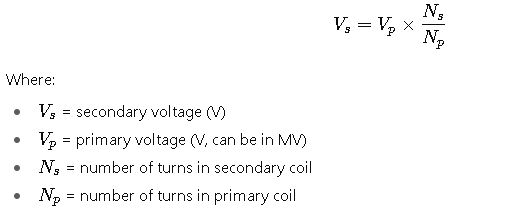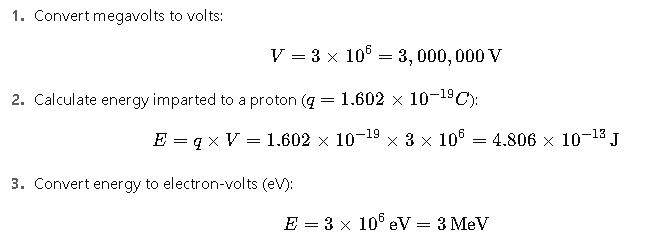In electrical engineering, accurate voltage measurements are critical. Megavolts (MV) measure extremely high-voltage systems reliably. Understanding conversion between megavolts and volts ensures engineers safely design and operate high-voltage equipment efficiently.
Megavolt to Volt Calculator
Formula used
Kilovolts (kV) = Megavolts (MV) × 1,000
Conversion Formula: Megavolt to Volt
The relationship between megavolts and volts is straightforward:
1 MV = 1,000,000 V
This implies that to convert a value from megavolts to volts, one must multiply the megavolt value by 1,000,000.
Conversion Table: Megavolt to Volt
| Megavolts (MV) | Volts (V) |
|---|---|
| 0.000001 | 1 |
| 0.00001 | 10 |
| 0.0001 | 100 |
| 0.001 | 1,000 |
| 0.01 | 10,000 |
| 0.1 | 100,000 |
| 1 | 1,000,000 |
| 10 | 10,000,000 |
| 100 | 100,000,000 |
| 1,000 | 1,000,000,000 |
This table illustrates the direct proportionality between megavolts and volts.
Practical Examples
Example 1: Particle Accelerator
In particle accelerators, such as the Large Hadron Collider (LHC), voltages can reach several megavolts. If a section of the accelerator operates at 5 MV, the corresponding voltage in volts would be:
5 MV × 1,000,000 = 5,000,000
This high voltage is necessary to accelerate particles to speeds close to that of light.
Example 2: High-Voltage Power Transmission
High-voltage transmission lines often operate at voltages in the range of hundreds of kilovolts. For instance, a transmission line operating at 400 kV is equivalent to:
400 kV = 0.4 MV
Converting this to volts:
0.4 MV × 1,000,000 = 400,000 V
This voltage level is used to efficiently transport electricity over long distances.
Factors Influencing Voltage Measurements
Several factors can affect voltage measurements:
- Measurement Equipment: The accuracy of voltmeters and other measuring instruments.
- Environmental Conditions: Temperature, humidity, and atmospheric pressure can influence readings.
- Electrical Interference: Nearby electromagnetic fields can cause fluctuations in measurements.
Safety Considerations
Working with high voltages requires stringent safety protocols:
- Insulation: Ensure all equipment is properly insulated.
- Personal Protective Equipment (PPE): Use appropriate PPE, including gloves and face shields.
- Training: Personnel should be trained in high-voltage safety procedures.
Detailed Formulas for Megavolt to Volt Conversion
While the basic formula is simple:
there are additional considerations and derived formulas used in engineering applications:
1. General Conversion
- MV: The voltage value in megavolts, typically ranging from 0.001 MV to several MV in high-voltage systems.
- V: The corresponding voltage in volts.
Common Values of MV and Corresponding V:
| MV | V |
|---|---|
| 0.001 | 1,000 |
| 0.005 | 5,000 |
| 0.01 | 10,000 |
| 0.05 | 50,000 |
| 0.1 | 100,000 |
| 0.5 | 500,000 |
| 1 | 1,000,000 |
| 2 | 2,000,000 |
| 5 | 5,000,000 |
| 10 | 10,000,000 |
2. Voltage Scaling in Transmission Systems
In power transmission, voltages are often scaled using transformers. The voltage at the secondary side can be calculated by:

This formula is directly relevant when working with megavolt-level transmission lines and converting readings to volts.
3. High-Voltage Equipment Design Formula
For high-voltage insulation design, the voltage in volts determines the required dielectric strength:
Where:
- E= electric field intensity (V/m)
- V= voltage across the insulation (V)
- d= distance of insulation (m)
This is crucial for systems operating in the megavolt range, ensuring insulation prevents breakdown.
Real-World Application Case Studies
Case Study 1: Lightning Protection Systems
Scenario: Designing a lightning protection system for a transmission tower operating at 1.5 MV.
Solution:
- Convert voltage to volts:
- Determine insulation distance using a safety factor:
Where Emax is the maximum allowable field strength for air (3 MV/m).
Conclusion: The tower requires at least 0.5 m of air insulation to safely handle voltage spikes.
Case Study 2: Particle Accelerator Power Supply
Scenario: A particle accelerator requires a 3 MV potential for the acceleration chamber.
Solution:

Conclusion: Each proton gains 3 MeV energy, confirming the system design aligns with desired particle acceleration.
Extended Table: Common Megavolt to Volt Values
| MV | V | MV | V |
|---|---|---|---|
| 0.001 | 1,000 | 5 | 5,000,000 |
| 0.005 | 5,000 | 10 | 10,000,000 |
| 0.01 | 10,000 | 20 | 20,000,000 |
| 0.05 | 50,000 | 50 | 50,000,000 |
| 0.1 | 100,000 | 100 | 100,000,000 |
| 0.5 | 500,000 | 200 | 200,000,000 |
| 1 | 1,000,000 | 500 | 500,000,000 |
| 2 | 2,000,000 | 1,000 | 1,000,000,000 |
Factors Affecting Practical Conversion
- Temperature: High temperatures can influence dielectric properties in equipment operating at megavolt levels.
- Load Conditions: Voltage under load may differ from no-load voltage; accurate measurement is required.
- Instrumentation Accuracy: High-voltage probes must be calibrated to avoid errors in conversion.
- Distance and Air Gap: For insulators and transmission lines, distance directly affects the voltage rating and safety margins.




